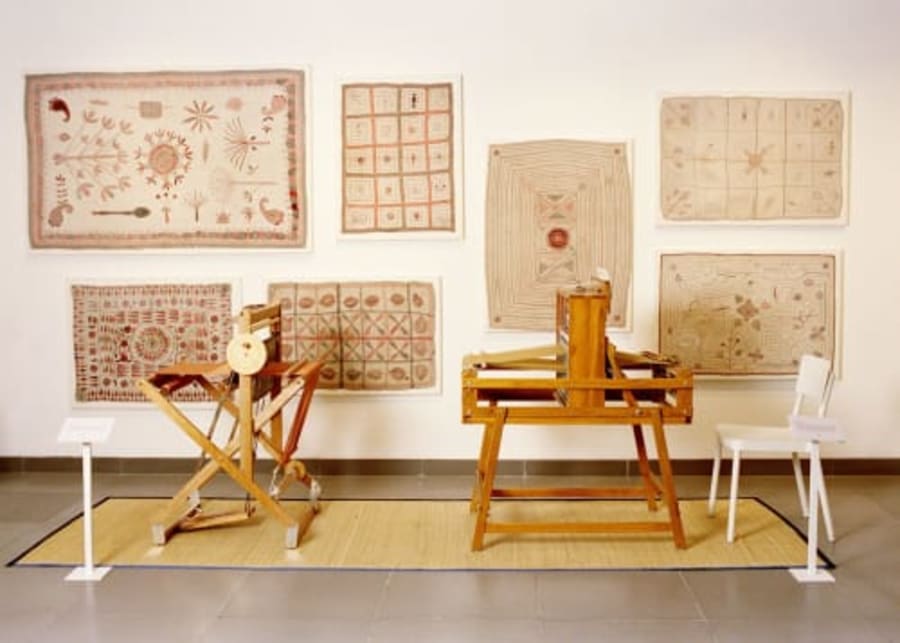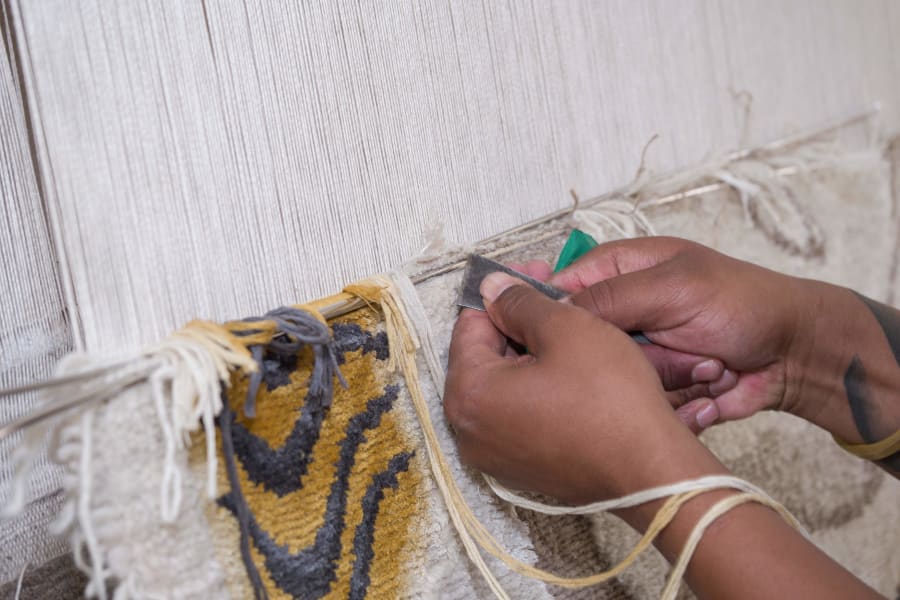A critical and transformative relationship with her Balinese heritage shapes Citra Sasmita’s artistic practice. Born and based on the island of Bali, Sasmita has a keen interest in the island’s cultural history: its colonial experience, its place in the popular exoticism of the tropical, and how its art scene has always been relegated to either archaeology, anthropology, or tourism. These are forms of inheritance that Sasmita critiques or transforms in a practice that extends from painting to installation, reconciling the canon of Javanese and Balinese cosmology with the feminist work of making women and their voices present.
‘Timur Merah’ is an ever-expanding series that Sasmita has been developing since 2019. It embodies the artist’s interest in how forms of inheritance can be actively harnessed to cultivate the potential of Balinese artistic practices and culture in mediating contemporary discourses. The works draw from the heteropatriarchal iconography of Kamasan scroll painting, which emerged in the 15th century in the Balinese village of the same name, and depict stories of heroic and noble men. Culturally significant throughout the island, they are usually festooned on the pillars or facades of family altars and temples. ‘I found that a lot of stories from ancient manuscripts only portray male heroism,’ Sasmita says. ‘They only talk about women in relation to their function for procreation and sexuality. If they portray a powerful woman, they will portray her as a monstrous figure.’ ‘Timur Merah’ re-envisions Balinese societal and cosmological imaginations by centering feminist perspectives. Sasmita populates scroll upon scroll with figures of black-haired women – ordinary and mystical, embodied and spectral, elemental, some on fire, others dripping in blood.
The first iteration of Timur Merah was presented at the Biennale Jogja in 2019. Titled Timur Merah Project I: Embrace of My Motherland (2019), the commissioned work comprised five vertical scroll paintings, a floor installation of text written with turmeric, and spice bags strewn across the room made from found Kamasan textiles that Sasmita sourced from tourist art stalls. Alluding to cosmological narratives of Nusantara, an Old Javanese term relating to the outer islands, as well as the genealogy of Javanese royalty, the scrolls show congregations of female figures, some with auras of electric yellow, some with flames enveloping them.
Sasmita sees the ‘Timur Merah’ series as a fragment of an entire cosmology that Balinese people have inherited. Literally ‘The East is Red,’ ‘Timur Merah’ alludes to the purifying connotations of blood and fire. ‘Red is a very important color in Balinese ritual culture,’ Sasmita explains. ‘It refers to bloodshed as in how we sacrifice animals when we return home. It is a form of respect for our ancestors. Red also refers to fire, an important symbol for purification. Blood and fire are our way of reconciling with whatever has happened in the past through ritual.’ Just as rituals are performances of reconciliation with the past, Sasmita’s work is her way of reconciling tradition with the contemporary.
A self-taught artist, who studied to become a physics teacher and started out as an illustrator for Bali Post in 2012, Sasmita has been learning from Kamasan painter and priestess for the last 6 years. She sources her canvases – which are handmade and reinforced with rice-flour glue, hand-stretched using seashells, and dried under the sun – from the same elder in Bali; the only surviving artisan that remembers the traditional way. While Sasmita uses acrylic paint, traditional Kamasan paintings exclusively used pigment from ochre stones sold by itinerant Bugis merchants from Makassar. The ochre stones were once harvested on Serangan Island until the 1994 reclamation project on the island, with the authoritarian regime of Indonesia’s longest serving president, Suharto, developing it as a tourism centre, making the sourcing and use of ochre stone impossible. Sasmita’s practice reflects these material and technological contexts as forms of inheritance as well.
‘Kamasan painting is not only about the story of the king. It is also about cosmology’, Sasmita points out. ‘There are strategies embedded into the pieces of information derived from Kamasan paintings. It is also a calendar and contains prophecies and thus can also be used as a guide to catastrophes and the changing world. Using Kamasan paintings, we can read natural phenomena, like earthquakes, which can tell us something about current political situations. Everything painted in a Kamasan painting is actually a coding of a situation and a prophecy, so that’s what I learned and became conscious of.’
In recent years, Sasmita’s work has been increasingly shown internationally. She received the Gold Award at the UOB Painting of the Year 2017 in Indonesia and, more recently, exhibited in the Thailand Biennale, Chiang Rai in 2023, the Biennale of Sydney and the Diriyah Biennale in 2024. In January 2025 she will open her first solo show in the UK at The Curve gallery at the Barbican in London. On being a Balinese artist in the global contemporary art scene, the artist offers a multilayered perspective. ‘A lot of Balinese artists who invoke contemporariness do not want to say that they represent Balinese art. However, since the art scene in Indonesia is always centered in Java, other islands of the archipelago are marginalized,’ she notes. ‘I think it is a very important statement to say that as island artists, our practices should always be rooted in authentic knowledges and aesthetics. The art world wants us to think with their geopolitical mindset about being global. But in the process, they are erasing fragments of important knowledges that are inherited by people living on small islands. We have to ask what the importance of Bali is in the context of a global contemporary, in the context of a geopolitical framework.’
For its most recent iteration at the Bienal de São Paulo, Timur Merah Project IX: Beyond the Realm of the Senses (2023), Sasmita added a sculptural element to her hanging scrolls. They were presented with a gold-painted replica of a figurehead found in the Kertha Gosa museum in Bali. The Kertha Gosa museum is built on the ruins of the Klungkung Royal Palace, where these Dutch figurines were installed alongside sacred sculptural motifs of the Holy Gate of the royal family temple. When the Klungkung royal family were forced into exile, Dutch administrators decided to renovate the temple and remove some of the sculptures of Hindu gods and goddesses and replace them with more secular figures commissioned from Balinese sculptors. ‘I wanted to reference this sculpture because of how parallel events are happening now in Bali,’ Sasmita says. ‘The government wants to renovate old temples in Bali to respond to local tourism.’
Through its many iterations, ‘Timur Merah’ has become a way for Sasmita to place herself – a traditional Balinese woman who creates contemporary art – in a longstanding tradition of artistic feminist critique and renewal. Talking about the project’s future, she imagines a tree growing. ‘I planted the seed from the first “Timur Merah” and then it started to grow. Its roots were the story of hell,’ she explains. ‘I don’t know if in the future this tree will grow more but I will continue to make them.’ Charged by a discerning relationship with the complexity of cultural inheritance, Sasmita’s paintings are an exercise in continually seeing oneself in this changing world.
Carlos Quijon, Jr. is an art historian and critic based between Manila and New York and is the curator of the Philippine Pavilion at the 2024 Venice Biennale.
Toronto Biennial of Art will be held from September 21 to December 1, 2024.
‘Citra Sasmita: Into Eternal Land’
From January 30 to April 20, 2025
The Curve, Barbican Centre, London
Caption for top image: Citra Sasmita, Timur Merah Project XI: Bedtime Story, 2023, commission artwork of Biennale of Sydney; Project IV: Tales of Nowhere, 2020 UOB commission for Children’s Art Space MACAN Museum. Photography by David James. Courtesy of Biennale of Sydney, 2024.
Published on August 22, 2024.


